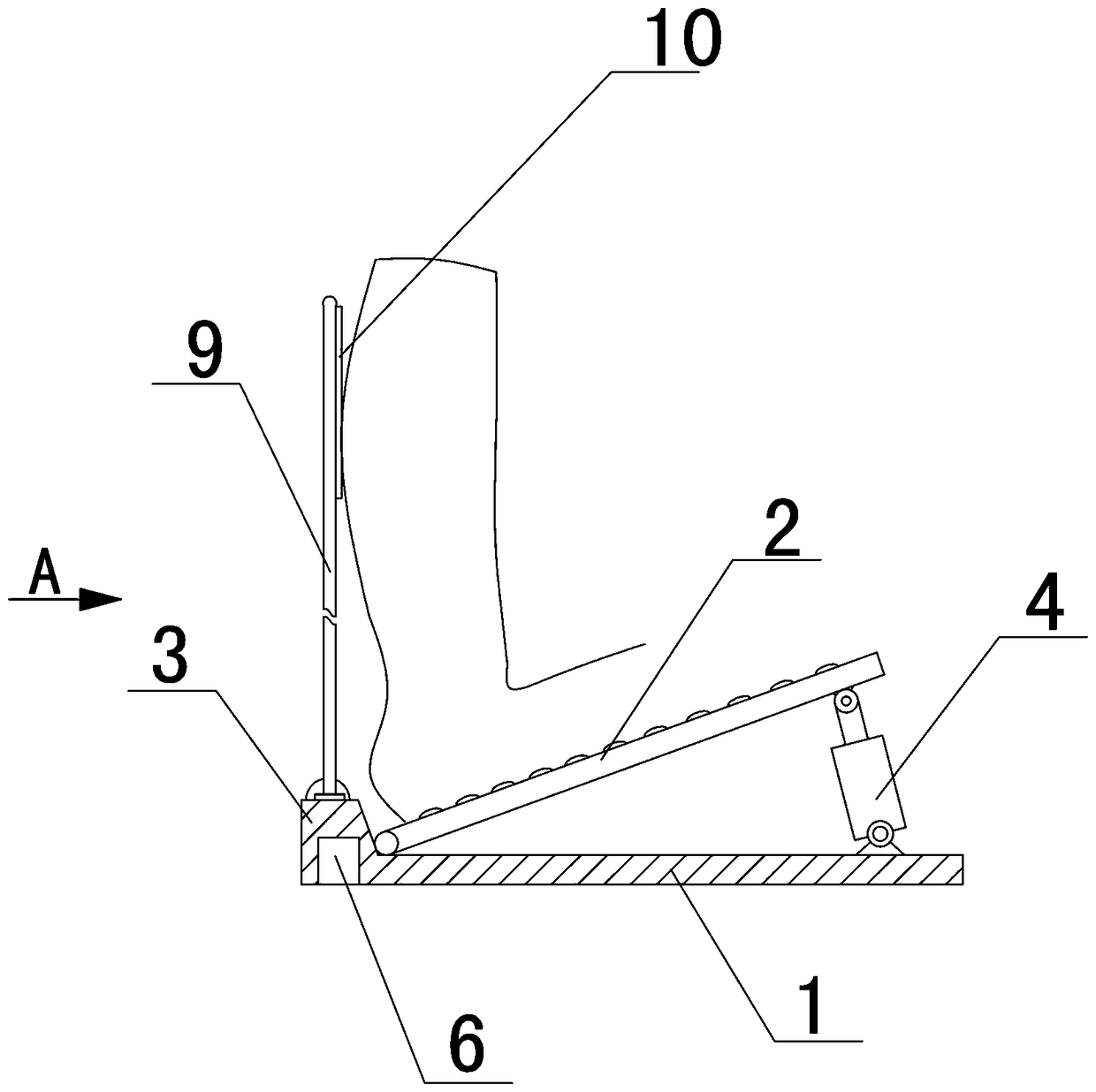Adaptive stepless tie piece plate with adjustable pedal angle
A pedal angle and self-adaptive technology, applied in the field of lacing boards, can solve the problems of inability to tighten the calf, affect the effect of lacing, and can not be done, so as to simplify the process of adjusting the inclination of the pedals, reduce the adjustment complexity, Avoid the effects of bad actions
- Summary
- Abstract
- Description
- Claims
- Application Information
AI Technical Summary
Problems solved by technology
Method used
Image
Examples
Embodiment 1
[0029] Such as Figure 1~Figure 3 As shown, a self-adaptive and stepless adjustable pedal angle lacing plate includes a bottom plate 1, a pedal 2. The lower end of the pedal 2 is hinged with the bottom plate 1, and the bottom plate 1 near the hinged end of the pedal 2 is provided with a foot stop 3 and a foot stop 3 A vertical detection rod 9 is fixed on the rear side, and a contact sensor is fixed to the front of the detection rod 9.
[0030] It also includes a controller 6, a pedal adjustment mechanism and a switch 7. The controller 6 is arranged at the bottom of the foot guard 3, and the pedal adjustment mechanism is arranged below the pedal 2. In this embodiment, the pedal adjustment mechanism is a push rod motor 4. The push rod motor 4 is hinged with the bottom plate 1. The top of the push rod of the push rod motor 4 is hinged with the upper part of the pedal 2, and the push rod extension of the push rod motor 4 can drive the pedal 2 to be hinged around Point rotation. A sw...
Embodiment 2
[0037] Such as Figure 4~Figure 6 As shown, an electric ribbed plate includes a bottom plate 1 and a pedal 2, and a foot stop 3 is provided at the lower end of the pedal 2. The left and right sides of the bottom plate 1 are respectively provided with a boss 11, the inner side of the boss 11 is provided with a front-to-rear long slideway 12, and a horizontal slide bar 13 is provided in the slideway 12 on both sides. The slide bar 13 can It slides back and forth in the slideway 12, and a front-to-rear propulsion rod 14 is fixed in the middle of the sliding rod 13, and the propulsion rod 14 is an internal threaded cylindrical structure. A rotating electric machine 16 is fixed on the base 1 below the pedal 2, and a screw 15 is fixed at the shaft end of the rotating electric machine 16. The shaft of the rotating electric machine 16 and the screw 15 are fixedly connected by a sleeve 17 to enable the two The connection is more stable. The external thread of the screw 15 matches the ...
specific Embodiment approach
[0040] First, turn on the power of the rotating motor 16 and the user stands on the pedal 2 with his heel close to the foot stopper 3, and the foot stopper 3 can prevent both feet from leaving the pedal 2. If the user needs to adjust the inclination angle of the pedal 2 to meet different degrees of leg stretching, just use the up button or down button of the foot switch 7 to drive the shaft of the rotating motor 16 to rotate forward or backward, thereby driving the lead screw 15 to rotate , The push rod 14 forwards or retreats, drives the sliding rod 13 to advance or retreat along the slideway 12, so that the bottom of the pedal 2 advances or retreats in the horizontal direction, the pedal 2 as a whole rotates around the hinge point of the support rod 18, thereby adjusting the tilt of the pedal 2 The effect of perspective. During the whole process, the user only needs to step on the switch 7 on the pedal 2 without leaving the pedal 2, which is convenient for the user to adjust ...
PUM
 Login to View More
Login to View More Abstract
Description
Claims
Application Information
 Login to View More
Login to View More - R&D
- Intellectual Property
- Life Sciences
- Materials
- Tech Scout
- Unparalleled Data Quality
- Higher Quality Content
- 60% Fewer Hallucinations
Browse by: Latest US Patents, China's latest patents, Technical Efficacy Thesaurus, Application Domain, Technology Topic, Popular Technical Reports.
© 2025 PatSnap. All rights reserved.Legal|Privacy policy|Modern Slavery Act Transparency Statement|Sitemap|About US| Contact US: help@patsnap.com



